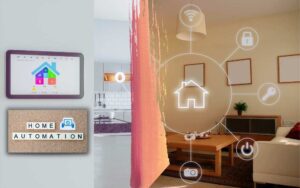Disclosure
The post may contain affiliate links, meaning we get a small commission if you make an account or purchase through our links, at no cost to you. This may help us to offset the cost of paying our writing team. For further detail visit our Affiliate Disclaimer
What if you wish to reduce the energy bill of your home and that only by using the major user of energy in your home. It is now possible due to SMART HVAC systems which reduce energy expenditures, minimize the workload, and enhance comfortable conditions for employees.
As per the study performed by the Sustainable Buildings Industry Council, commercial and residential buildings consume approximately 72% and 41% of electricity produced in the U.S. In 2010.
Before we proceed towards our topic in detail we should know about the basics of SMART Technology and its related terminology first i.e SMART Buildings.
Table of Contents
What is a SMART Building?

A SMART building is an advanced system of interconnected building systems. Like the Internet, it connects individual computer networks into one larger super network. More specifically any structure that employs automated procedures to regulate the building’s operations, such as heating, ventilation, air conditioning, lighting, security, and other systems.
Smart buildings boost the value of a property for developers and owners. Smart buildings employ Building management systems that monitor heating, lighting, and ventilation, software packages. The system automatically turns off equipment like laptops, cameras, lighting when offices are vacant.
Since the invention of SMART buildings, it has made much progress to improve building energy efficiency over the past decades. The potential to reduce energy consumption in existing and new commercial buildings is enormous. As per the U.S. Environmental Protection Agency on average, commercial buildings account for 30% of the energy wastage.

SMART HVAC Systems
An HVAC system is a device that can deliver required temperature air (cool or warm) when there is a requirement. This process requires a huge amount of energy, which estimates at least around 40% of a commercial building’s energy. HVAC operators typically manage by trial-and-error modifications in response to occupant comfort input, putting energy savings on the least priority.
While on the other hand SMART HVAC systems are capable of saving a significant amount of energy while enhancing occupant comfort and reducing energy conservation simultaneously. They use sensors that integrate with your building automation system. They allow you to adjust the temperature, humidity, and airflow in different zones (based on sensor data), to improve comfort.
Methodology & Devices Used

1. Multiple Zones Controlling
One of the most successful applications of SMART HVAC systems, in multi-zone systems, is optimizing the usage of conditioned air. In a multi-zone variable air volume (VAV) system, Smart controls, for example, VAV boxes, condition each of the zones. The working of each VAV box is in such a way to cycle back or shut off entirely as per occupancy. When the majority of the employees are out of the office, the smart controls may turn down or turn off the air conditioning in any or all of the zones and hence saving energy.
2. Using SMART Sensors to Optimize Operations
Sensors are electronic devices that detect and transform physical stimuli into signals. For example, the degree of resistance against air passing through a duct is measured by a duct static pressure sensor. Building operators use these static pressure values to manage HVAC systems efficiently by running the system at a certain duct static pressure, moreover, it is also used to identify various faults in the system.
3. Fault Detection and Diagnostics
SMART HVAC systems mainly provide the sensing of leaks, blockages, and deterioration in the equipment as they are usual occurrences in the HVAC systems. These defects are frequently unnoticed usually until the proper maintenance is not carried out of the system. These controls enable the operators to detect any of the irregularities in the system, resolve them proactively in order to save the system from failure.
This method of automated fault detection includes a combination of sensors and algorithms so as to compare the projected operating condition of the equipment or system to actual performance.
4. Window Shading
As per the study conducted about one-third of commercial building HVAC energy use is due to heat gains and losses from windows. The California Energy Commission estimates that approximately 40% of the cooling requirement for a typical building is due to solar heat gain through windows. To reduce this heat gain following are the different types of shades used worldwide;
a. Manual shades – A low-cost measure for reducing solar heat gain and radiation

b. Motorized window shades – Same philosophy of operation as manual one except they are controlled by switches or analog timers.
c. Solar-adaptive shades – Detect indoor and outdoor ambient temperatures, as well as the sun’s location and radiation, and alter their height accordingly to control the quantity of light and heat entering the space

d. Active, or Electrochromic – is electrically controlled and the process of window tinting is driven by a low voltage in response to solar intensity and ambient temperature. It changes from opaque to clear depending on the electrical charge.
Five Benefits of Upgradation to SMART HVAC Systems
Few are some of the major benefits of using this technology ;
1. Better Control Remotely
You can modify the temperature from anywhere with a few taps on the screen. You just need your smartphone for this either you are in your house or out and about.
2. Energy Efficient System
Switching to a smart HVAC system reduces your carbon footprint in addition to energy consumption and is an excellent first step toward being more ecologically conscious.
3. Improved Air Quality
The device also detects increased carbon dioxide levels and the system increases the volume of fresh air in the room, maintaining a consistent degree of comfort.
4. Better Variance Provision
It is possible to heat or cool particular rooms in an efficient manner. This feature allows you to maintain your room at the temperature you choose without bothering the rest of your home.
5. User Friendly Interface
Whether you are controlling the HVAC and cooling systems from your smartphone, computer, a sensor, or directly on the smart thermostat, you have a user-friendly interface that is simple, clear, and usable.
Conclusion
Although SMART Technology is a relatively newly introduced technology, it has already had a deep impact on the HVAC business. Looking at the acceptance of this technology, it can be assumed that installing smart HVAC systems in buildings will be standardized in the upcoming years.
The widespread use of smart HVAC systems will eventually alter how corporations determine power prices. The adoption would enable “variable pricing” terminology in which families will purchase energy-based on supply and demand.
By optimizing energy consumption, smart HVAC makes our facilities more sustainable. Nevertheless, automation of HVAC is only the first step of the green transformation of our buildings. There’s a lot more to dig up for SMART building’s future.


